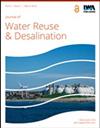The perspective of a smart city by endorsing the nexus Bermuda triangle with the risk assessment of polluted water reuse in integrated water and food security management: the case of Semnan, Iran
IF 2.3
Q2 Environmental Science
引用次数: 1
Abstract
In the paradigm of circular economy, the reuse of treated wastewater in agriculture is currently regarded as a possible solution for alleviating the issues of water scarcity and pollution. Accordingly, this research aims to assess the use of polluted water in the integrated management of water resources in Semnan. The research used the Water Evaluation and Planning System (WEAP) software package to model and analyze the water sector. Also, the Bayesian network method was used to assess the risk of using polluted water and its effects on humans and plants. The research explored two general scenarios for the study site of Semnan. The first scenario assumes the increase in population, crops (food), and industries, and the second has the same assumptions plus an increase in agricultural efficiency (food production). Based on the results, the agricultural, urban, and industrial water demands are 37, 0.06, and 0.01 million m3 in the base year, respectively. The water demand in the next years will be higher due to the population growth. Finally, it is safer to use the wastewater of both treatment plants of the region (Mehdishahr and Semnan) in the industry than in other sectors.在水和粮食安全综合管理中,通过对污染水再利用的风险评估,认可百慕大三角关系,从智慧城市的角度来看:以伊朗塞姆南为例
在循环经济模式下,农业废水的再利用目前被认为是缓解缺水和污染问题的可能解决方案。因此,本研究旨在评估塞姆南水资源综合管理中污染水的使用情况。本研究使用水资源评估和规划系统(WEAP)软件包对水资源部门进行建模和分析。此外,还使用贝叶斯网络方法来评估使用污染水的风险及其对人类和植物的影响。该研究探讨了Semnan研究地点的两种一般情况。第一种情况假设人口、作物(粮食)和工业增加,第二种情况假设相同,加上农业效率(粮食生产)增加。根据结果,基准年农业、城市和工业用水需求分别为3700万m3、0.06万m3和0.01万m3。由于人口增长,未来几年的用水需求将更高。最后,在工业中使用该地区两个处理厂(Mehdishahr和Semnan)的废水比在其他部门更安全。
本文章由计算机程序翻译,如有差异,请以英文原文为准。
求助全文
约1分钟内获得全文
求助全文
来源期刊

Journal of Water Reuse and Desalination
ENGINEERING, ENVIRONMENTAL-WATER RESOURCES
CiteScore
4.30
自引率
0.00%
发文量
23
审稿时长
16 weeks
期刊介绍:
Journal of Water Reuse and Desalination publishes refereed review articles, theoretical and experimental research papers, new findings and issues of unplanned and planned reuse. The journal welcomes contributions from developing and developed countries.
 求助内容:
求助内容: 应助结果提醒方式:
应助结果提醒方式:


